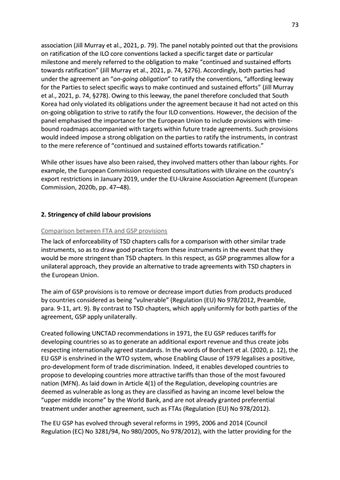73 association (Jill Murray et al., 2021, p. 79). The panel notably pointed out that the provisions on ratification of the ILO core conventions lacked a specific target date or particular milestone and merely referred to the obligation to make “continued and sustained efforts towards ratification” (Jill Murray et al., 2021, p. 74, §276). Accordingly, both parties had under the agreement an “on-going obligation” to ratify the conventions, “affording leeway for the Parties to select specific ways to make continued and sustained efforts” (Jill Murray et al., 2021, p. 74, §278). Owing to this leeway, the panel therefore concluded that South Korea had only violated its obligations under the agreement because it had not acted on this on-going obligation to strive to ratify the four ILO conventions. However, the decision of the panel emphasised the importance for the European Union to include provisions with timebound roadmaps accompanied with targets within future trade agreements. Such provisions would indeed impose a strong obligation on the parties to ratify the instruments, in contrast to the mere reference of “continued and sustained efforts towards ratification.” While other issues have also been raised, they involved matters other than labour rights. For example, the European Commission requested consultations with Ukraine on the country’s export restrictions in January 2019, under the EU-Ukraine Association Agreement (European Commission, 2020b, pp. 47–48).
2. Stringency of child labour provisions Comparison between FTA and GSP provisions The lack of enforceability of TSD chapters calls for a comparison with other similar trade instruments, so as to draw good practice from these instruments in the event that they would be more stringent than TSD chapters. In this respect, as GSP programmes allow for a unilateral approach, they provide an alternative to trade agreements with TSD chapters in the European Union. The aim of GSP provisions is to remove or decrease import duties from products produced by countries considered as being “vulnerable” (Regulation (EU) No 978/2012, Preamble, para. 9-11, art. 9). By contrast to TSD chapters, which apply uniformly for both parties of the agreement, GSP apply unilaterally. Created following UNCTAD recommendations in 1971, the EU GSP reduces tariffs for developing countries so as to generate an additional export revenue and thus create jobs respecting internationally agreed standards. In the words of Borchert et al. (2020, p. 12), the EU GSP is enshrined in the WTO system, whose Enabling Clause of 1979 legalises a positive, pro-development form of trade discrimination. Indeed, it enables developed countries to propose to developing countries more attractive tariffs than those of the most favoured nation (MFN). As laid down in Article 4(1) of the Regulation, developing countries are deemed as vulnerable as long as they are classified as having an income level below the “upper middle income” by the World Bank, and are not already granted preferential treatment under another agreement, such as FTAs (Regulation (EU) No 978/2012). The EU GSP has evolved through several reforms in 1995, 2006 and 2014 (Council Regulation (EC) No 3281/94, No 980/2005, No 978/2012), with the latter providing for the













